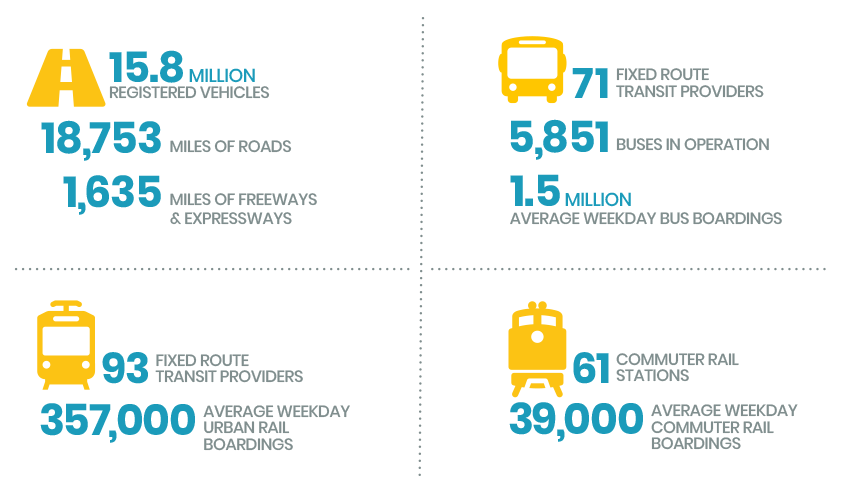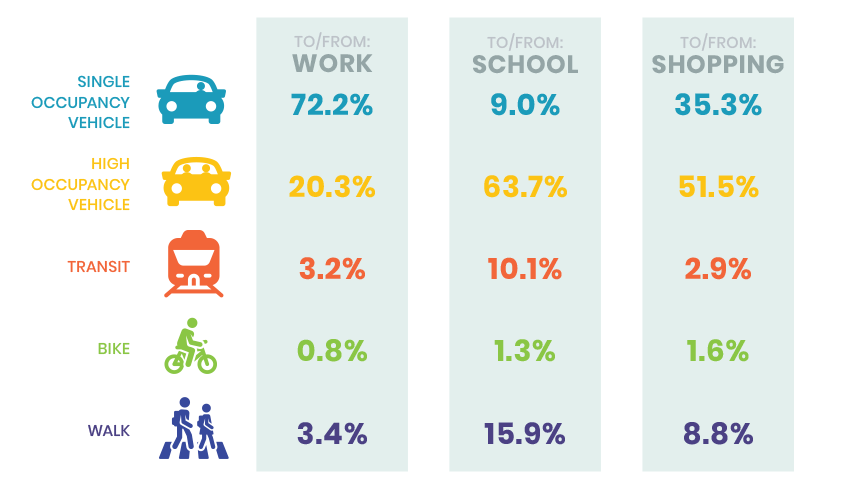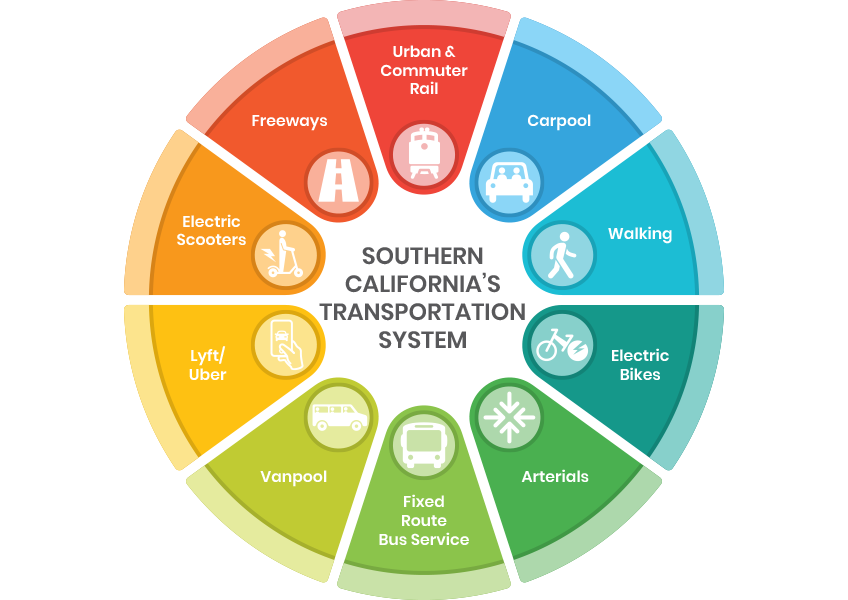How Will We Connect?
Southern California covers a large geographic area, and therefore many think of our region as a seemingly endless network of freeways and highways where the “car is king.” The six-county SCAG region, however, is more than that – our region is home to a multi-modal system that connects the people and goods of one of the world’s largest mega-regions to the destinations where they live, work and play. With over 1,600 miles of freeways and expressways, over 100 miles of urban rail lines, over 4,000 miles of bikeways, and six major airports, Southern California needs multiple modes of transportation to move both people and goods. As we look toward the future, we will need to think about how our region will connect internally, to the rest of the nation, and to the world.
Our current transportation system is also the highest source of greenhouse gas emissions. According to Next 10’s Green Innovation Index, vehicle emissions hit a record high in 2017, accounting for 41 percent of the state’s total. With ambitious state mandates to reduce our emissions within the next fifteen years, we need to examine what kinds of alternatives to driving can be utilized to provide a cleaner travel experience, whether it be for work or leisure.
Due to the widespread reliance on the automobile, one major issue we’re currently dealing with is traffic congestion. With the average commuter losing over 100 hours every year trapped in traffic, what can we do to get people where they need to go quickly and safely? Southern California is one of the worst traffic hot spots in the world and we’ve compiled a menu of solutions that could be utilized such as expanded transit, safer walking and biking options, “Go Zones” and first/last mile options to help reduce the time people spend in their cars so they can spend more time on what matters most.
The region’s transportation system in 2045 needs to be different than what it is in 2020. To get to this vision of future connectivity, we need to understand what kind of system we have now so we can understand the types of choices that will be needed to better connect our region in the future. Right now, the automobile is still the most popular mode of transportation in our region. It is utilized most often to get people to-and-from work, as well as for most trips in general.
How We Travel Today
The multi-modal system we have today provides a number of options for people to move around the region. Whether by freeways, public transportation, carpool, active transportation, Lyft and Uber, or electric scooters and bikes, there is something for everyone. Connect SoCal will not necessarily change how everyone chooses to get around, but instead is designed to offer residents more choices for transportation and mobility. This includes thinking about what kinds of disruptive emerging technologies have the potential to change transportation and mobility. Improved access to data, as well as new ways data is utilized, will offer improved strategies for addressing our biggest transportation challenges. By providing more options for local and regional trips, emerging technologies may shift trips to less environmentally damaging modes, minimize negative environmental impacts associated with current vehicle use, increase system efficiency, improve safety, and reduce auto-related collisions and fatalities.
In order to provide a sound transportation system for the region’s 19.2 million residents, and the additional 3.6 million that will call Southern California home in 2045, we need to address the challenges of today to provide a robust and effective system tomorrow. We will see increased demands on our system. Current trends show some declining usage of public transportation, necessitating intervention. Our network is in many ways inefficient in moving people and goods. There is a lack of coordination between land use and transportation investments. With the assistance of transportation demand management (TDM) strategies, we can reduce the demand for roadway travel, particularly from single–occupancy vehicles, so we can concentrate investments on projects that can reduce congestion and shift trips to other more efficient modes. Maintaining and enhancing a transportation system that can tackle these challenges, however, will require adequate funding, and securing that funding for a better transportation system will be perhaps the region’s biggest challenge.
As we approach the 2045 sunset of Connect SoCal, we envision more compact communities that are connected seamlessly by numerous public transit options, including expanded bus and rail service. People will live closer to work, school, shopping and other destinations. Their neighborhoods will be more walkable and safer for bicyclists. They will have more options available besides driving alone, which will reduce the load on our roads and highways. People will have the opportunity to live more active and healthy lifestyles as they bike, walk, or take transit for short trips. With increased transportation options, goods will flow freely along roadways, highways, rail lines, and by sea and air into and out of the region.
It’s not all doom-and-gloom! We have a real opportunity right now to support investments in our transit operators to develop a public transportation system that betters supports the needs of our residents. This will address critical gaps in networks and services, providing more choices and opportunities for people to get to work or school. Advances in communications, computing and engineering—from shared mobility innovations to zero-emissions vehicles—can lead to a cleaner and more efficient transportation system. As our region’s demographics change, there will also be a greater desire for housing situated closer to jobs, healthcare, shopping, and other amenities, and more mobility options for everyone.
Meeting these challenges, and creating the conditions and infrastructure that result in increased mobility, easier access to destinations, and more transportation options, is a daunting task, but we are living at a time of technological and economic innovation that will help us meet those challenges.




